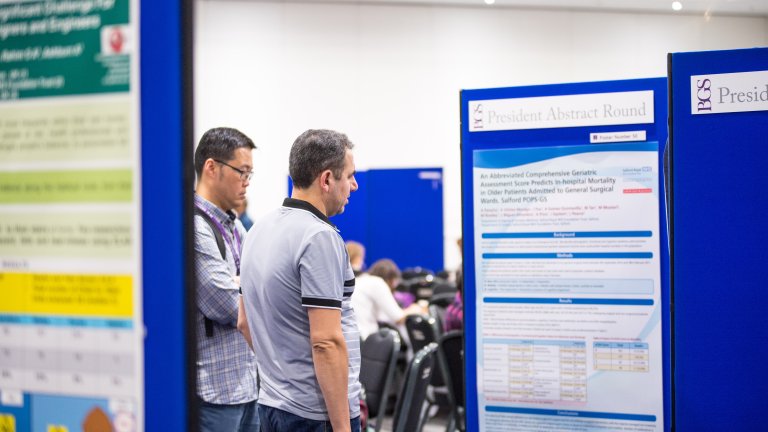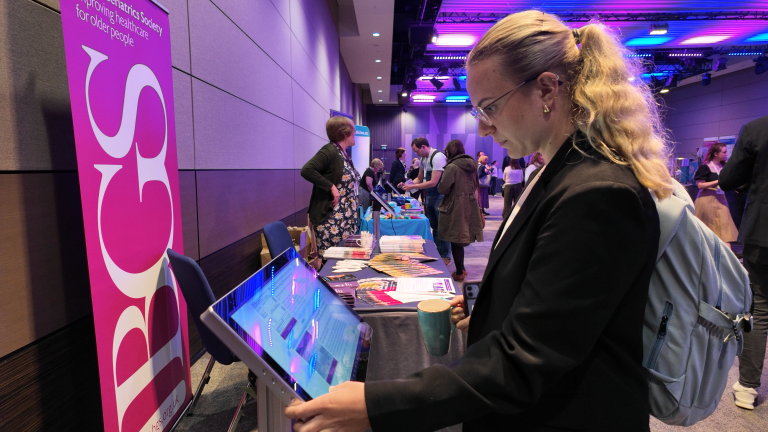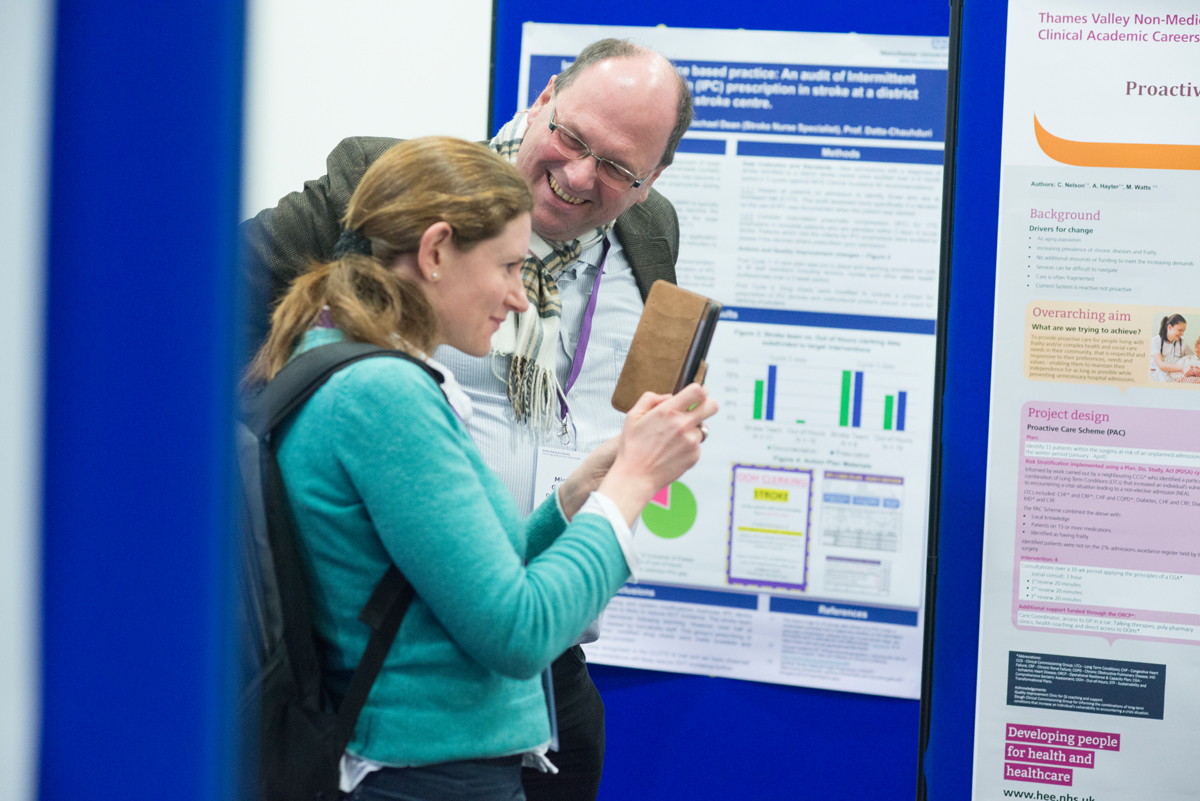Presenting your work
There is little point in carrying out research if no-one gets to hear about the results, and unpublished data benefits no-one. Think of it as equivalent to writing in the notes in clinic: if it isn't written down, it hasn't been done. Another reason to present is to make sure that possible future employers see that you are contributing to geriatrics.
There are two main ways of letting the outside world know about your research results: publication in a scientific journal and presentation at scientific meetings. This article focuses on oral and poster presentations at meetings. Please do also review this recommended language guide when preparing your work.
Think early on when planning your research about how you will communicate the results - think about what people will want to know, and this will influence what data you collect.
What is the audience for your results? Geriatricians? Then present at BGS or regional conferences. Cardiologists? Go to the British Cardiac Society or European Society of Cardiology.
The abstract
Common problems to avoid are:
- Failing to read the instructions. Failing to follow the instructions is a good way of getting your abstract rejected.
- Stick to the word limit. The body of the abstract may have a separate word limit from the title and authors names.
- Don't try and present too much data (although you must include some). Abstracts are short, and seem to be getting shorter!
- Pick one simple message to get across and no more. If the data in your abstract doesn't help get the message across, leave it out.
Poster presentations
Making the poster:
- Plan your poster several weeks in advance. This gives enough time for it to be printed.
- Make sure what is on the poster matches the abstract; the best approach is to start with the text of your abstract and expand; put in some more introduction, more detailed methods. Keep the conclusion the same as in your abstract.
- Make the writing big - it should be visible from at least 1.5m away.
- Find out whether portrait or landscape format is required and what size it should be.
- Ask your local University media dept or NHS medical media dept how to get the poster printed. They will usually have preset formats and styles for producing posters; you can often just concentrate on the text and tables. Pictures are fine, but they are not a substitute for interesting data.
- Take drawing pins and Velcro - they may be provided, but it is best to be on the safe side
- Put the poster in a plastic tube and carry it as hand luggage. It doesn't really matter if your suitcase is lost, but it does matter if your poster is lost.
- Think about the questions that you will be asked by interested parties and prepare some answers. Get a colleague to look over the poster critically
- Find out when the poster should be in place by, when you may take it down, and when the judging (if any) occurs)
- Be next to your poster whenever you can; the more people you can talk to about your work, the more rewarding you will find the experience.
Oral presentations
General points:
- Presenting is about communicating a set of ideas from your brain to the brains of others. If you don't manage to do this, your presentation has failed.
- To communicate effectively you need to know your audience. Is this an audience mainly of clinicians who will be looking for the clinically relevant points? Or is it a more specialist audience who need to know more about, say, your methods?
- Always tailor your presentation to the needs and interests of each audience. A 20 minute talk to your workmates cannot be effectively delivered to the BGS conference in 10 minutes. Make every presentation fit the purpose.
Making your slide presentation:
- Always remember that the purpose of your slide presentation is to augment your talk, not to distract from it. You and what you say should be the focus of attention for the audience.
- Blue background, yellow writing. This is easiest to see, and works in low or high light levels.
- Avoid animation. It is distracting and rarely adds anything to a presentation.
- Don't use videos unless you really know what you are doing. They usually go wrong, which interrupts your presentation.
- Keep to a maximum of six pieces of information per slide. Large tables should always be avoided - no-one has the time to read them even if the numbers are visible. If you have to apologise for a 'busy' slide, it shouldn't be in there. Simplify it!
- Lay out your talk in the same way as your abstract.
- Do not spend a long time thanking everyone in the lab, all of your mentors etc. It is not Oscar night. Put it on one slide and thank the funding body.
- Short talks (up to 10 minutes) can use a maximum of two slides per minute, though one is better. The longer the talk, the less slides per minute you should attempt to show. Talks above 45 minutes should not be allowed; no-one in the audience can concentrate on a talk for longer than about 40 mins.
- The ideal speed for speaking is about 100 words per minute. A simple rule is - 1 slide per minute, with 100 spoken words per slide.
Giving your talk
The key to success is preparation. Good preparation effectively curtails nerves, helps you get the message across clearly, and makes you look good. Excellent speakers invest at least one hour of practice per minute of their talk. Certainly you should have practised the talk at least 10 times before. And practising means delivering the talk exactly as you want it to be delivered on the day. Glancing through your slides is not enough. It is nerve-wracking and sometimes painful, but practising to colleagues, particularly senior ones, is extremely valuable. Even worse, you can record yourself on tape - most people are shocked by how many 'umms' and 'ahhs' they emit during a talk. However, hearing yourself on tape really helps to you correct things in advance.
Timing is crucial. Most people go on for far too long, a few are very nervous and rush through. A minute too short is better than 30 seconds too long - you will keep the chairperson happy, the audience will love you.
- Prepare for questions. Many can be anticipated. Force people to ask you hard questions - once you've answered them in practice, it's a lot easier to answer them at the meeting.
- Dress soberly and smartly. Your talk, not your clothes should be the topic of conversation.
- Express confidence through your body language. You shouldn't have anything to hide.
- Speak up - but avoid getting too close (within six inches) to the microphone.
- When you have finished, shut up. Don't waffle on after you have delivered your main message.
Some people prefer to read from a pre-prepared text, others prefer to use reminder cards with key points, still others prefer to ad-lib using slides as a prompt. You will need to experiment to see which technique works best for you, but if you are inexperienced at public speaking, I would strongly recommend that you use one of the first two methods. The shorter the talk, the more important every word becomes, and the more carefully you should plan what you will say. A tip - good speakers often memorise the first 90 seconds of their talk. This is not hard to do and is great for relieving nerves and creating the impression of competence and authority.
Do not read what is on the slide verbatim. The audience are quite capable of doing this for themselves, it wastes valuable time and it is very boring.
On the day, make sure that:
- You know where and when you are due to present. Get there in plenty of time - preferably the day before.
- Your talk is loaded onto the computer well before you are due to present, and make sure that you know how the equipment works - especially how to go back a slide! Check the presentation to make sure that the colours or presentation size are the same as they were on your computer at work.
- If you don't understand the question someone asks, say so. Many questions at scientific meetings are irrelevant or incomprehensible (some are statements, rather than questions).
- If you don't know the answer to the question, say so. Do not try and waffle - no-one is impressed and it wastes everyone's time. The whole purpose of scientific meetings is to exchange information. People ask questions to clarify ideas in their mind and to get more information. It is not a school test. No-one has ever done a perfect study. Your study is bound to have weaknesses and problems, so don't be afraid to acknowledge them.
- Succinct, clear answers are much more impressive than umm-laden mini-talks. Keep your answers brief and relevant.
- Remember, you're the expert: 95 per cent of the audience knows less about the topic than you, so although you feel nervous, you still know more than the people that you are talking to.





